Understanding Aortic Disease

The aorta is the largest artery in the body. It carries oxygen-rich blood from your heart to the rest of your body. Disorders and conditions that affect the aorta are called aortic diseases.
It’s important to know:
- Diseases of the aorta are serious and can be life-threatening.
- They happen when the walls of the aorta become weak and bulge, split, burst or block up.
- Aortic bulges or swellings are called aneurysms.
- 95% of aortic aneurysms do not cause symptoms.
- Age is a major factor in developing an aortic aneurysm.
- Aortic diseases are not as common as some other heart conditions.
- Treatment may include monitoring, medicine, less invasive surgery, open aortic surgery, or open-heart surgery.
- Screening for aortic aneurysms can save lives.
What is aortic disease?
The aorta, our largest blood vessel, takes blood from the heart to the rest of the body. Many smaller blood vessels branch off it. It is shaped like a candy cane and has four sections.
Ascending aorta: This is where the aorta leaves the heart and goes up towards the neck, before curving.
Aortic arch: This is the curved part of the aorta between the ascending and descending aorta. Arteries taking blood to the head and arms branch off here.
Descending aorta: After the arch, the aorta extends down through the chest.
Abdominal aorta: The aorta continues below the ribs down to the groin.
Parts of the aorta may be more than an inch wide. It has thick walls so that it doesn’t burst under the pressure of the blood that runs through it.
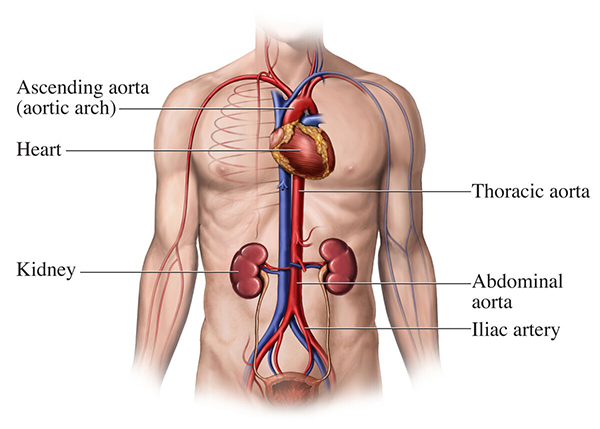
Medical Illustration Copyright © 2022 Nucleus Medical Media. All rights reserved.
Aortic disease can put the heart and the whole body’s blood supply at risk. It can occur when:
- The aortic wall is weakened or damaged.
- The heart’s aortic valve narrows or doesn’t open fully.
- There is a blockage in the aorta.
Types and symptoms of aortic disease
Aortic aneurysm and rupture
Abdominal aortic aneurysm: A bulge or swelling on the lower part of the aorta that runs through the belly area (abdomen).
Thoracic aortic aneurysm: A bulge or swelling on the part of the aorta that runs through the chest.
Aortic aneurysm rupture: A complete tear or rupture through all three layers of the aortic wall causes the aorta to burst.
Symptoms: 95% of aortic aneurysms do not cause any symptoms. Aneurysms are often found during screenings for other conditions.
If an aneurysm is large or growing fast it may press on other organs causing pain in the chest or belly, but nearly all aneurysms grow without causing any symptoms. The larger an aneurysm is, the more likely it is to rupture.
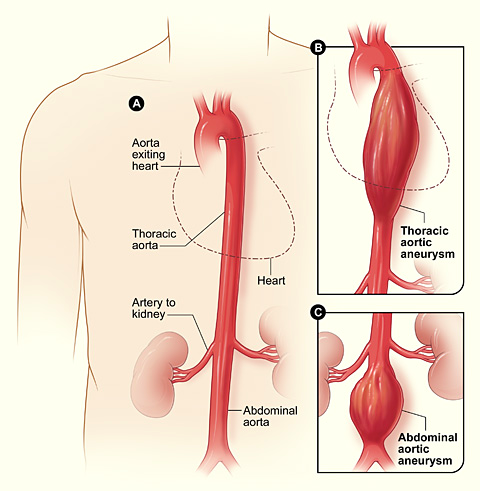
Aortic dissection
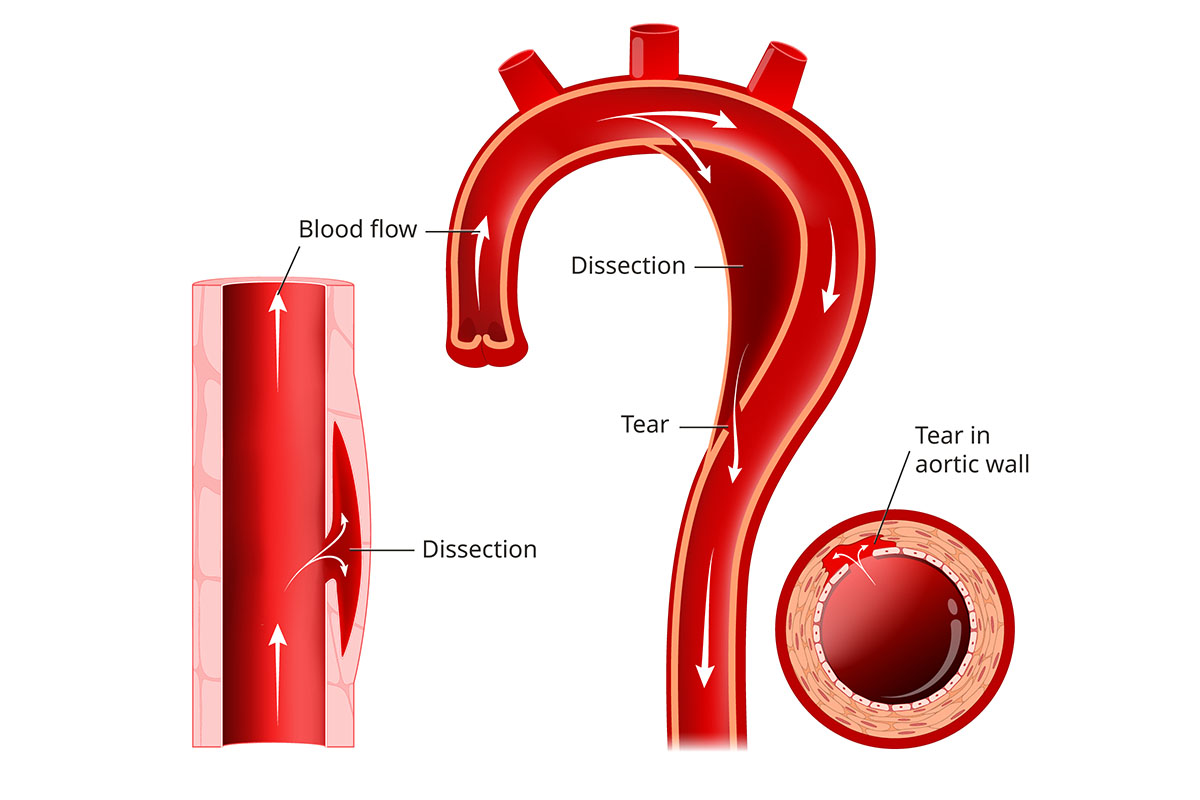
Aortic dissection: A tear in the inner layer of the aortic wall. When blood enters the tear, the layers of the wall separate. This weakens the aortic wall and can lead to aneurysm or rupture.
There are two types of aortic dissection:
Type A: A split in the upper part of the aorta, where it leaves the heart and goes up toward the arch. This is a life-threatening emergency and usually needs surgery. It is the more common type.
Type B: A tear in the descending part of the aorta where it extends down through the chest and abdomen.
Symptoms are similar to those of other heart problems:
- Sudden tearing pain in the chest or upper back
- Fainting and dizziness
- Shortness of breath
- Stroke-like symptoms such as trouble speaking, weakness in one side of the body, loss of vision
- Sweating
- Confusion
Symptoms of Aortic Dissection
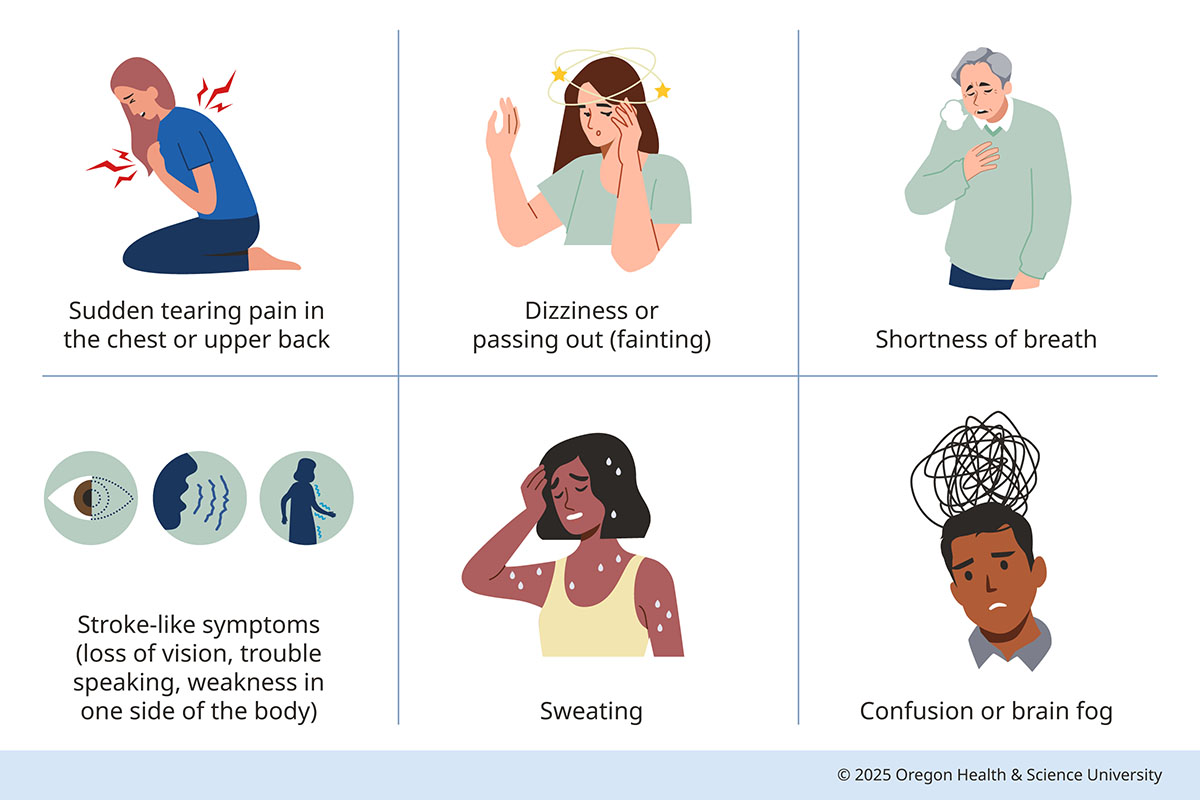
Aortic valve stenosis
This is when the valve between the aorta and the heart narrows or doesn’t open all the way. This blocks blood from flowing into the aorta and to the rest of the body. It can lead to heart failure. Learn more about heart valve disease.
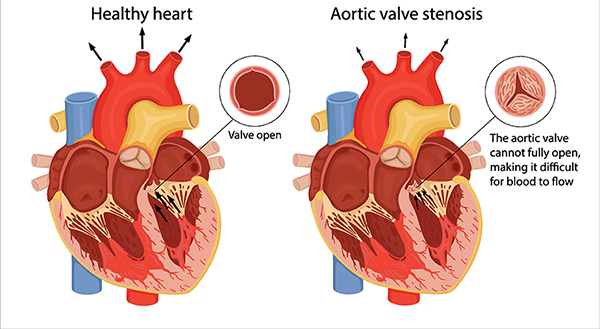
Symptoms: Like aneurysms, stenosis may have no symptoms unless it is severe. Severe stenosis causes symptoms similar to those of other heart problems:
- Heart murmur or palpitations
- Chest pain
- Fainting and dizziness
- Shortness of breath
- Fatigue
Symptoms of Severe Aortic Valve Stenosis
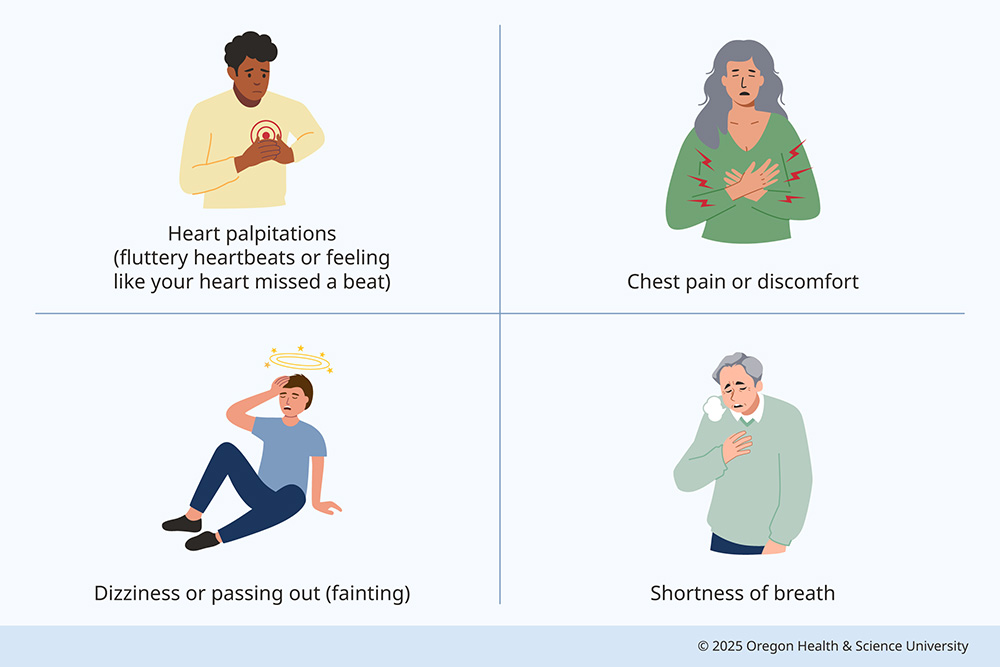
Aortic occlusion
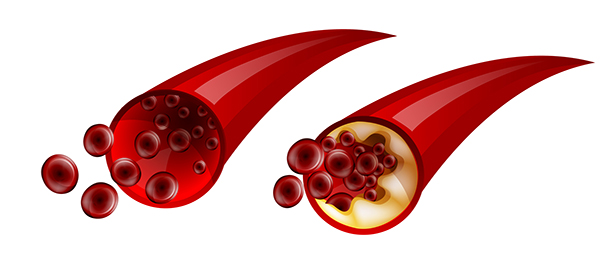
A blockage of the aorta anywhere along its path. This can block blood from flowing throughout the body and cause long-term damage to organs. A complete block of the aorta, or acute aortic occlusion, is a rare life-threatening emergency.
Symptoms: Occlusion may cause no symptoms until it becomes severe. Some people have fatigue or pain in their legs.
Who gets aortic disease?
According to the Society for Vascular Surgery, about 200,000 people in the U.S. are diagnosed with an abdominal aortic aneurysm each year. Abdominal aortic aneurysms are the 10th leading cause of death for men in the U.S.
Thoracic aortic aneurysms are less common, happening in less than 10 of every 100,000 people per year. Men and women are equally at risk. They become more common with age.
Aortic rupture is very rare, and almost always caused by an aortic aneurysm that bursts.
Aortic dissection is rare, happening in about 3 of every 100,000 people per year. It affects both men and women.
Aortic valve stenosis is the most common heart valve disease. The American Heart Association found that more than 20% of people over 65 in the U.S. have aortic valve stenosis.
Aortic occlusion can be caused by many conditions, including plaque build-up in the arteries, birth defects, and swelling from inflammation.
Risk factors for aortic disease include:
- Age
- Being male
- Smoking
- High blood pressure
- High cholesterol
- Atherosclerosis (causes plaque to build up in the arteries
- Obesity
- Family history
- Genetic disorders such as Marfan syndrome, Ehlers Danlos syndrome and Loeys-Dietz syndrome
Screening and prevention
Screening for aneurysm can save lives. Talk to your doctor about whether screening is right for you. Doctors recommend ultrasound screening for men 60 and older who have ever smoked or used tobacco products, and for people who have a family history of aneurysm.
You can lower your risk of aortic disease:
- Don’t smoke or use tobacco products. Smoking is a strong risk factor for aortic aneurysm.
- Eat a heart-healthy diet
- Keep your weight at a healthy level
- Get regular exercise
Learn more
- Aortic Aneurysm, Centers for Disease Control and Prevention
- Aortic Aneurysm, National Heart, Lung, and Blood Institute
- Your Aorta: The Pulse of Life, American Heart Association
Locations
Physicians Pavilion
3270 S.W. Pavilion Loop
Portland, OR 97239
OHSU Beaverton Cardiovascular Clinic
15700 S.W. Greystone Court
Beaverton, OR 97006
Refer a patient
- Refer your patient to OHSU.
- Call 503-494-4567 to seek provider-to-provider advice.